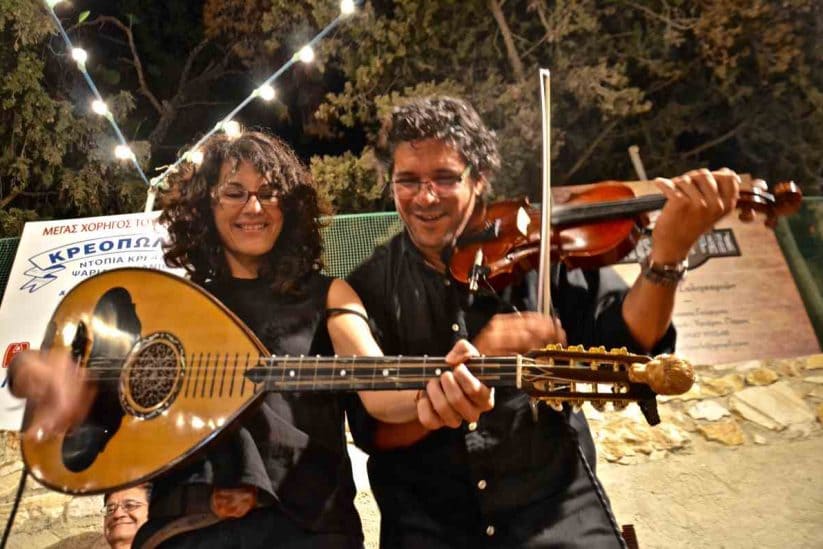
You are using the Free Edition of ParosAPP. For extensive information on Paros, GO PRIME with our comprehensive Greek Travel App featuring the full editions of Paros and 25 more Greek islands & Athens.

Throughout the year locals and tourists alike celebrate the island’s traditional festivals. Some are religious, others cultural, but all are joyously celebrated with delicious food, plenty of wine and music.
In addition to major celebrations such as Easter and Christmas, each village celebrates the Saint whom the local church is named after (Panayiria as they are called in Greek) . The celebrations begin with a church service and are followed by a festival with live Greek music and traditional dancing, lots of traditional foods and plenty of ‘souma’ and local wine. Visitors are welcomed with open arms. The festivals take place on their squares or in the churches’ courtyards, the day before the feast or on the day of the feast of the Saint.
Don’t miss the opportunity to join in and celebrate with traditional food and song:
Welcome to the island calendar, where each month is a chapter in Paros’ vibrant tapestry of traditions and festivities!
January 1st – New Year’s Day (Proto Chronia): It’s a day of presents and good wishes. Bake or bite into Vassilopita, the special cake with a hidden coin for a year of good luck.
January 6th – Epiphany (Stavro): Brave youths dive into the frozen Aegean waters to retrieve the cross. Parikia and Naoussa host lively celebrations.
Carnival – Two-Week Festivities: The island transforms during Carnival. The last week is all about fancy-dress parties. Don your mask and join the revelry!
“Tsiknopempti” – Smokey Thursday: The second Thursday of Carnival, a carnivore’s delight! Indulge in grilled meats and spontaneous street barbecues.
Clean Monday (Kathari Deftera): A day to feast on octopus, calamari, taramosalata, and Clean Monday bread. Witness kites flying in Aliki.
March 25th – Greece’s National Day: Commemorate the national-liberation struggle of 1821. Parades, Doxologia mass at Ekatontapiliani, and events across villages.
Good Friday: Candlelit processions fill the streets, particularly in Parikia, creating an impressive spectacle.
Holy Saturday (Megalo Savato): Midnight Mass, darkness symbolizing Jesus’ journey, and the joyous moment of resurrection with fireworks and a blessed flame.
Easter Sunday (Kyriaki tou Pascha): Roasted lamb or goat over open fires, feasting, drinking, and dancing.
April 23rd – Festival of Saint Georgios in Agairia.
May 1st – May Day or Labour Day: Picnics and wreath-making from wild spring flowers.
May 8th – Festival of Saint Ioannis Theologos in Drios.
June 23rd – Kleidonas Festival: Solemnity, fires in Aliki, Naoussa, and Prodromos. Music, dance, traditional delicacies, and jumping over fires to ward off evil spirits.
June 24th – Saint Athanasios the Parian in Kostos.
June 30th – Festival Eve at the monastery of Saint Anargyron.
July 2nd – Fish and Wine Festival in Naoussa: Notable events and activities.
July 16th & 17th – Festival of Saint Marina in Kostos.
July 17th – Revival of the “Tsabouna” (bagpipes) in Naoussa.
July 24th – Festival of Saint Anna in Parikia.
July 26th – Festival of the churches of Saint Panteleimonas in Kostos and Prodromos.
August 6th – Festival of Sotiros in Aliki and Marpissa.
August 15th – Analipsi tis Panagias – Assumption of Mary: The most important festival with a grand celebration, processions, and spectacular fireworks.
August 23rd – Firework Display in Naoussa: Commemorating the invasion by pirate Barbarossa, with a unique twist of pirates snatching away girls.
August 27th – Festival of Saint Fanourios in Ampelas.
August 28th & 29th – Feast of Saint Ioannis Detis in Lefkes.
Early September – Celebration of the Trata in Parikia: A traditional festival with seafood, wine, and souma.
September 8th – Celebration of Panagia Faneromini in Marmara.
September 14th – Ypsoseos tou Timiou Stavrou: A celebration in Agairia with Divine Liturgy, traditional delicacies, and dances.
October 28th – Ochi Day: Remembrance services, military parades, folk dancing, and feasting.
November 25th – Feast of Saint Aikaterini in Lefkes: Divine Liturgy, procession, and memorial day for the Resistance of the Greeks.
December 25th – Christmas Day (Christougena): Religious services and feasting, with boats often adorning Christmas decorations.
Celebrate the rich tapestry of Paros, where each festival weaves tales of history, tradition, and the vibrant spirit of the island!
